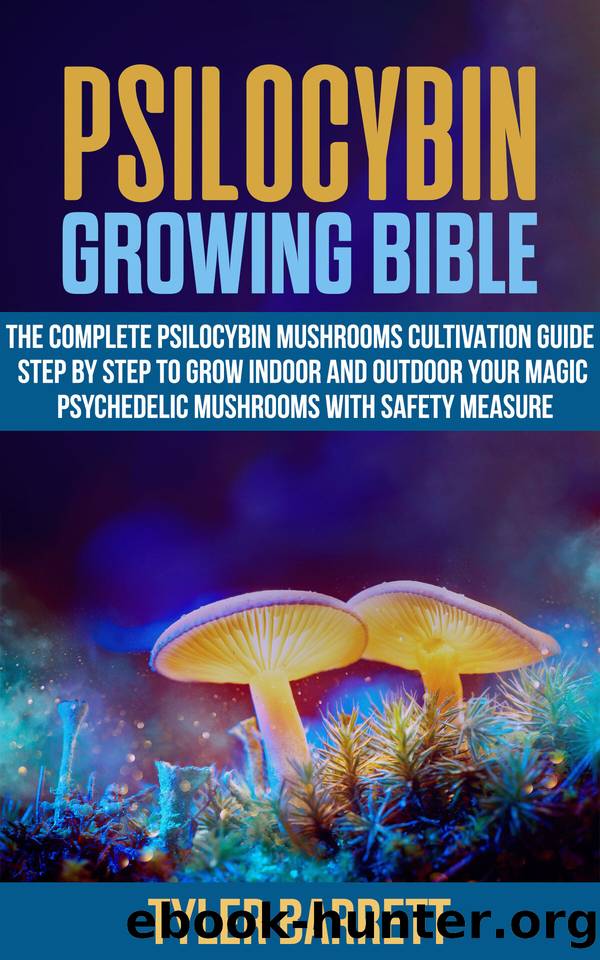Psilocybin Growing Bible: The Complete Psilocybin Mushroom Cultivation Guide Step by Step to Grow Indoor and Outdoor Your Magic Psychedelic Mushrooms with Safety Measure. by Tyler Barrett

Author:Tyler Barrett [Barrett, Tyler]
Language: eng
Format: azw3
Published: 2020-05-01T16:00:00+00:00
Chapter 7
Casing soil
M ost cultivated species of mushrooms, like Psilocybe cubensis, can yield rich fruit only if the substratum is covered in a soil-like layer known as a casing layer. For example, peat moss or vermiculite, along with gypsum and calcium carbonate, are typically composed of non-nutritious materials with high water-holding capacities. The casing layer serves a number of important mushrooms producing capacities. The coating is helping to protect the substratum from losing its moisture to the atmosphere because of its high-water content. It provides a humid microenvironment within which the delicate primordia can develop, and it serves as a water-saving to draw on the parched mushrooms as they grow. Since the case layer takes up and discharges water like a wash, it also helps a grower to hold a bed comfortably at its ideal level of moisture thus reducing the risk of waterlogging the substratum and suffocating the fungus.
Furthermore, the amount of moisture on the particulate casing layer is often easier to "catch" than on exposed colonized soil, thereby enhancing the humidification process. Many recipes for the casing soil include mineral salts, such as chalk and gypsum. To some degree, peat moss is acidic, and mushroom mycelium often oozes acidic metabolites as they grow. Since a highly acidic atmosphere can damage the fungus and support the growth of microscopic organisms, the addition of chalk (calcium carbonate) to the casing soil helps to maintain a slightly necessary condition (a pH of 7.5-8.5). Gypsum (calcium sulfate) is added to help preserve a free, vaporous structure, and provide the developing fungus with mineral sustenance as calcium and sulfur. Assumed "water crystals" are arbitrary fixations that you can apply to your casing mix. Made of a synthetic polymer chemically associated with super paste, these crystals can assimilate 400 times their weight in water, and then slowly discharge it back into their atmosphere. They look like crisp gelatin when fully hydrated.
They are used to monitor water use in agriculture and gardening, and to protect plants from drying out completely between watering. Similarly, the addition to a casing layer of only a small amount of water crystals would serve to keep it hydrated and reduce the need for steady misting. A single flush of mushrooms will ransack a considerable amount of water from the casing and substratum, and these crystals can give your cultures an extra degree of protection from drying out. Despite being a synthetic substance, water crystals have been tested and shown to be non-harmful and kindhearted to the environment. We absolutely convert to carbon dioxide and water after some time. We have even been experimentally tested for protection when used in growing mushrooms. Catch mushrooms (Agaricus bisporus) grown in their presence have not been shown to corrupt or introduce the gel's chemical constituents.
The crystals come in two assortments: ones made from sodium or others made from potassium. Since significant levels of sodium are harmful to numerous fungi, make certain to get the kind made from potassium. Because the crystals debase when heated, they should be added in the wake of disinfecting or sanitizing the casing soil.
Download
This site does not store any files on its server. We only index and link to content provided by other sites. Please contact the content providers to delete copyright contents if any and email us, we'll remove relevant links or contents immediately.
| Anatomy | Animals |
| Bacteriology | Biochemistry |
| Bioelectricity | Bioinformatics |
| Biology | Biophysics |
| Biotechnology | Botany |
| Ecology | Genetics |
| Paleontology | Plants |
| Taxonomic Classification | Zoology |
Sapiens: A Brief History of Humankind by Yuval Noah Harari(14252)
The Tidewater Tales by John Barth(12608)
Mastermind: How to Think Like Sherlock Holmes by Maria Konnikova(7227)
Do No Harm Stories of Life, Death and Brain Surgery by Henry Marsh(6891)
The Thirst by Nesbo Jo(6828)
Why We Sleep: Unlocking the Power of Sleep and Dreams by Matthew Walker(6618)
Life 3.0: Being Human in the Age of Artificial Intelligence by Tegmark Max(5474)
Sapiens by Yuval Noah Harari(5294)
The Longevity Diet by Valter Longo(5021)
The Body: A Guide for Occupants by Bill Bryson(4974)
The Rules Do Not Apply by Ariel Levy(4861)
The Immortal Life of Henrietta Lacks by Rebecca Skloot(4525)
Animal Frequency by Melissa Alvarez(4395)
Why We Sleep by Matthew Walker(4360)
The Hacking of the American Mind by Robert H. Lustig(4318)
Yoga Anatomy by Kaminoff Leslie(4306)
All Creatures Great and Small by James Herriot(4233)
Double Down (Diary of a Wimpy Kid Book 11) by Jeff Kinney(4207)
Barron's AP Biology by Goldberg M.S. Deborah T(4098)
